Texas Birds With Blue Feathers Tan Front Texas
The Lone Star state, home of some of the best barbecue and chili on the planet, is also the home to a staggering number of birds. Today we'll talk about some of the birds that you can see in cattle and oil country and give you some key information for bringing those avian wonders we all adore just one step closer. Let's talk about the popular backyard birds of Texas!
3 Categories – 600 Birds
Texas does everything big but it's still pretty amazing to hear that this state is the permanent or occasional home of somewhere in the neighborhood of 600 birds! Now, of course we can't list them all and if we did, it would take all week to read, so for simplicities sake we've created a 'sampler'. Let's divide up the seasons into 3 key categories:
- Year-round Resident birds
- Birds of Spring, Summer, and Early Fall
- Fall and Winter Birds
This will help you to know WHEN to look for these birds and in each entry we'll also let you know what these birds like to eat and where they like to hang out. After that you can load up your feeder and the rest is up to the birds!
Texas's Year-Round Resident Birds
These birds are Texans, tried and true, and while they don't have little guns and cowboy hats they've definitely got gusto. You can see the following birds at anytime of the year in Texas:
- Bachman's Sparrow
- Inca Dove
- Vermilion Flycatcher
- Brown-headed Nuthatch
- Northern Mockingbird
Bachman's Sparrow – Peucaea aestivalis

Coloration and Markings: The Bachman's Sparrow has brown and gray wings with a touch of rust-red in them. They have long gray and brown tails with a white breast and tan underbelly. This bird has a tan 'bib' that extends into the upper breast and sometimes has streaks of rust as well. Facially, this bird has the tan bib up to under the chin while the rest of the face is gray and brown. There are eyelines visible going through and passing ever the eyes and the eyes often appear to be outlined in white. This bird has a rusty crown on it's brow and a short and stout, slightly curved black bill.
Size: This bird measures in at 4.9 – 6 inches in length with a wingspan of approximately 7.2 inches.
Habitat: These birds love pine trees and palmetto scrubs, as well as areas that simply have a lot of high grass so that they can frolic and forage with a little bit of cover.
Diet: These birds are a prized sighting, as they are fairly rare, but you can prepare your feeder with dried mealworms and crickets as well as Black Oil Sunflower and other seeds to ensure that there is food waiting should this elusive backyard bird make an appearance. Ground feeders are a must.
Inca Dove – Columbina inca

Coloration and Markings: Designed for camouflage, The Inca Dove is draped in desert colors. It has tan wings and back, with the feathers edged in black, and a long tan and black tail. When the bird is in flight you can see some light brown under the wings and white under the tailfeathers. The breast and underbelly of this bird are the same color but lighter and facially you'll see the same colors as the rest of the body, with even the long bill only showing black at the tip. This bird has an eyering but it can be tricky to spot with the rest of the coloration and pattern employed in this bird's plumage.
Size: This bird measures in at 7.1 – 9.1 inches in length with a wingspan of 11 – 12.5 inches.
Habitat: These birds are fairly urbanized and comfortable walking around sidewalks and other open areas as long as there is a little shrub cover nearby to duck into for safety.
Diet: Black Oil Sunflower seeds, millet, wheat, and oats are all attractive snacks for the Inca Dove, but you will want to utilize a ground feeder.
Vermilion Flycatcher – Pyrocephalus obscurus

Coloration and Markings: Flycatchers are sometimes a little drab in the plumage department but not so with the Vermilion Flycatcher. This one's a looker! This bird has dark brown wings and tail while the breast and underbelly are a brilliant orange-red. This orange-red coloration continues to the face, interrupted only by a mask-band which extends in a wavy fashion to the back of the head. This bird has a small, straight black bill.
Size: This birds measures an average length of 4.8 – 5.4 inches with a wingspan of 9.5 to 10 inches.
Habitat: At home where desert scrub abound or just as much at riverside forest areas of the Lone Star state, you can look for this bird on shrubs or fences.
Diet: While primarily insectivorous, these birds sometimes eat cactus fruits or small berries. Try some chopped up or whole cherries or strawberries and you might have some luck luring a Vermilion Flycatcher.
Brown-headed Nuthatch – Sitta pusilla

Coloration and Markings: The Brown-headed Nuthatch has gray-blue back and shoulders with the rest of the wings and the tail being gray to dark-gray. White spots are often visible on the underside of the tail when this bird is in flight. They have a white breast and underbelly and facially we get a color shift. This bird has a brown head from the level just under the eye and continuing to the back of the neck, while the lower half of the face is white. A white spot on the back of the head might be glimpsed if this bird is close and this bird has a long, straight black bill.
Size: These tiny birds measure in at 3.9 – 4.3 inches in length with wingspans of 6.3 to 7.1 inches.
Habitat: These birds love Pine forests but they will venture forth to visit backyard feeders for a much-needed winter calorie boost.
Diet: These birds are easy to please, just include a suet feeder in your arsenal and the Brown-headed Nuthatch will take advantage once they know that it is there.
Northern Mockingbird – Mimus polyglottos
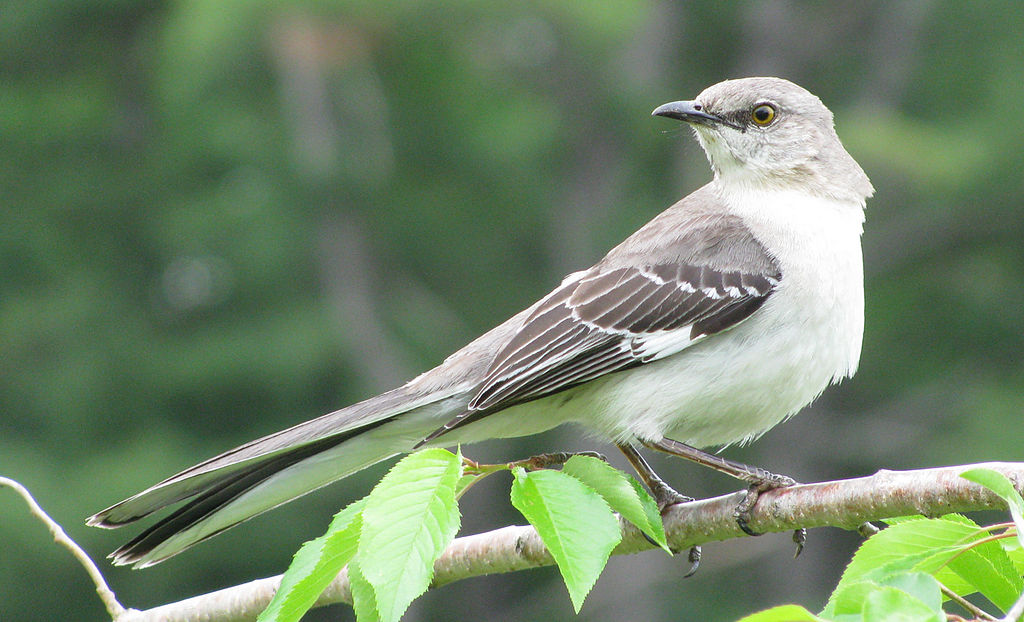
Coloration and Markings: The Northern Mockingbird has a gray back and wings, with the wings displaying 2 distinctive wingbars which show as a large, white patch when this bird is in flight. It has along, gray tail, andis white at the breast and underbelly, going all the way up to under the bill. Facially, this bird is gray on the upper half of the head and a gray line goes from the eye and frames the cheek in the lower portion of the face, which is white. Finally, a black line goes from the small, slightly curved black bill and terminates at the front of the eye.
Size: These birds measure in at 8.3 – 10.2 inches in length with wingspans of 12.2 to 13.8 inches.
Habitat: When they aren't singing at the forest's edge, these birds are quite civilized. You can find them all over the city as well as parks and perhaps your own backyard!
Diet: Northern Mockingbirds can be easily tempted with a suet feeder but if you really want to treat them mix some chopped apples and raisins and leave it out. They'll love you and are sure to sing for their supper.
Texas's Birds of Spring, Summer, and Early Fall
Spring in Texas begins and the birds come in flocks for the warm winds and the worm-calling rains that mean feasting and warmer weather. There are a number of birds you can look for in Texas during spring, summer, and early fall and we've selected a few examples to keep your eye out for:
- House Sparrow
- Barn Swalllow
- White-winged Dove
- Pileated Woodpecker
- Yellow-billed Cuckoo
House Sparrow – Passer domesticus
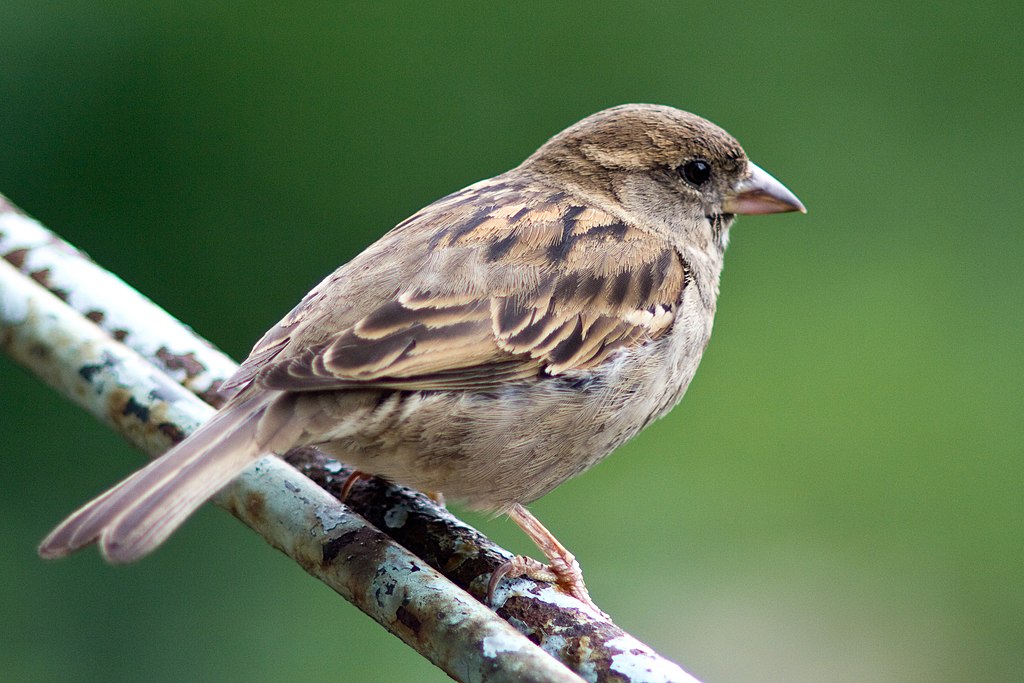
Coloration and Markings: House Sparrows have brown wings and tails with black highlights with grayish-white breast and underbelly. This bird has a distinctive black bib and facially it is tricolor, with the area around the cheek being white followed with a curving brown mask and finally silvery gray at the top of the head. These birds have short, stout and slightly curved black bills. Females will be much more brown but will still have the 'dirty gray' breast and underbelly.
Size: This bird measures in at 5.9 – 6.7 inches in length with a wingspan of 7.5 to 9.8 inches.
Habitat: The closest these city birds will get to a forest is a wooded farm. They are commonly seen on telephone poles, fences, and sidewalks and frequently visit feeders that have been stocked in anticipation of their arrival.
Diet: Seeds and grains will sate this Sparrow, try stocking up with BlackOil Sunflower seeds, millet, and cracked corn for best results.
Barn Swalllow – Hirundo rustica
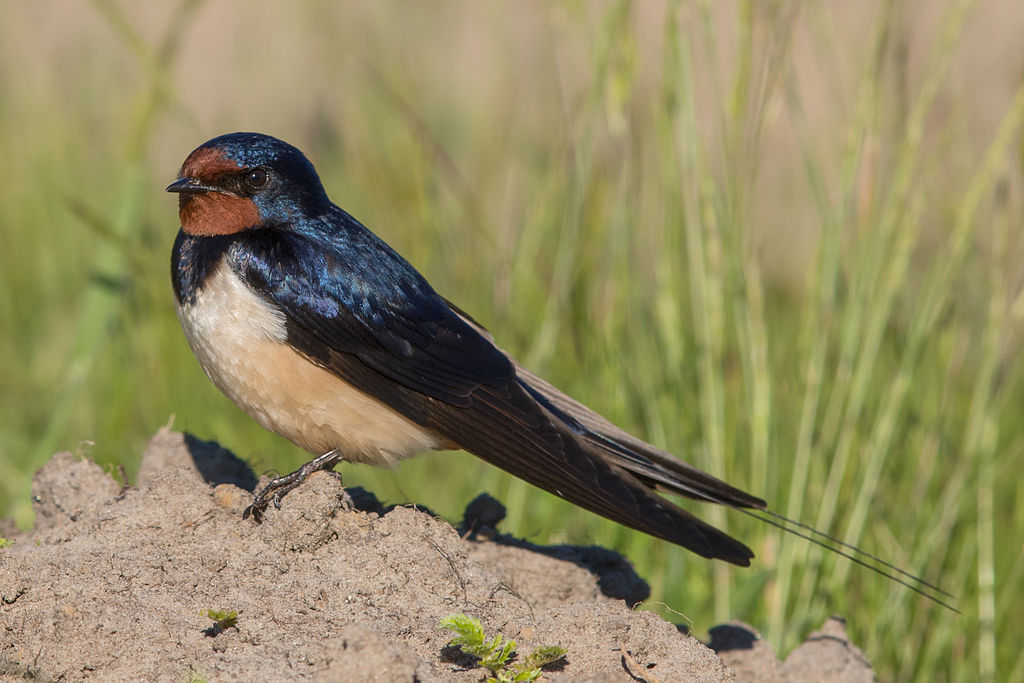
Coloration and Markings: Barn Swallows have simple but beautiful coloration. Their backs, wings, and tails are a striking blue (with the wings sometimes going to blue-gray beyond the shoulders) and the breast and underbelly are a rich, reddened-orange. The blue color extends onto the breast as a line on each side, almost as if this bird were wearing a blue feather-cape. Facially, this bird has the red-orange coloration on the lower portion of the face, forming a peak just above the short black bill, with the rest of the upper portion of the head being blue. This bird also has a black, often diamond-shaped mask as well.
Size: These birds measure in at 5.9 – 7.5 inches in length with wingspans of approximately 11.4 to 12.6 inches.
Habitat: These birds like open areas such as parks and fields and they are also attracted to water, foraging close to ponds and marshes.
Diet: These birds prefer to get their food in the wild but you can tempt them by placing crushed eggshells in a feeder. It is believed that they eat these to assist with digestion.
White-winged Dove – Zenaida asiatica

Coloration and Markings: White-winged doves are tan-brown on their back and wings, with the exception being the thick, white edges on each wing. They have short, white-tipped tails, with some black accents at the rump-feathers, and on the underside of their tails are gray with black striping. They have a gray and white underbelly and breast and facially you'll notice a black line on the cheek of the mostly-tan head. The only other non-tan portions of the head are the blue skin around the often-red eyes and their medium-sized, curved black and gray bill.
Size: These Doves measure in at 4.4 – 6.6 inches in length with an average wingspan of 18.9 to 22.8 inches.
Habitat: These are desert birds and as such you'll find them around cacti or scrub, though they are frequent backyard visitors as well. They are quite keen on birdbaths.
Diet: These birds love lots of feeder foods. You can put out Black Oil Sunflower, Safflower, milo, and cracked corn and when they get bored of that they'll start on your Blackberry bushes!
Pileated Woodpecker – Dryocopus pileatus
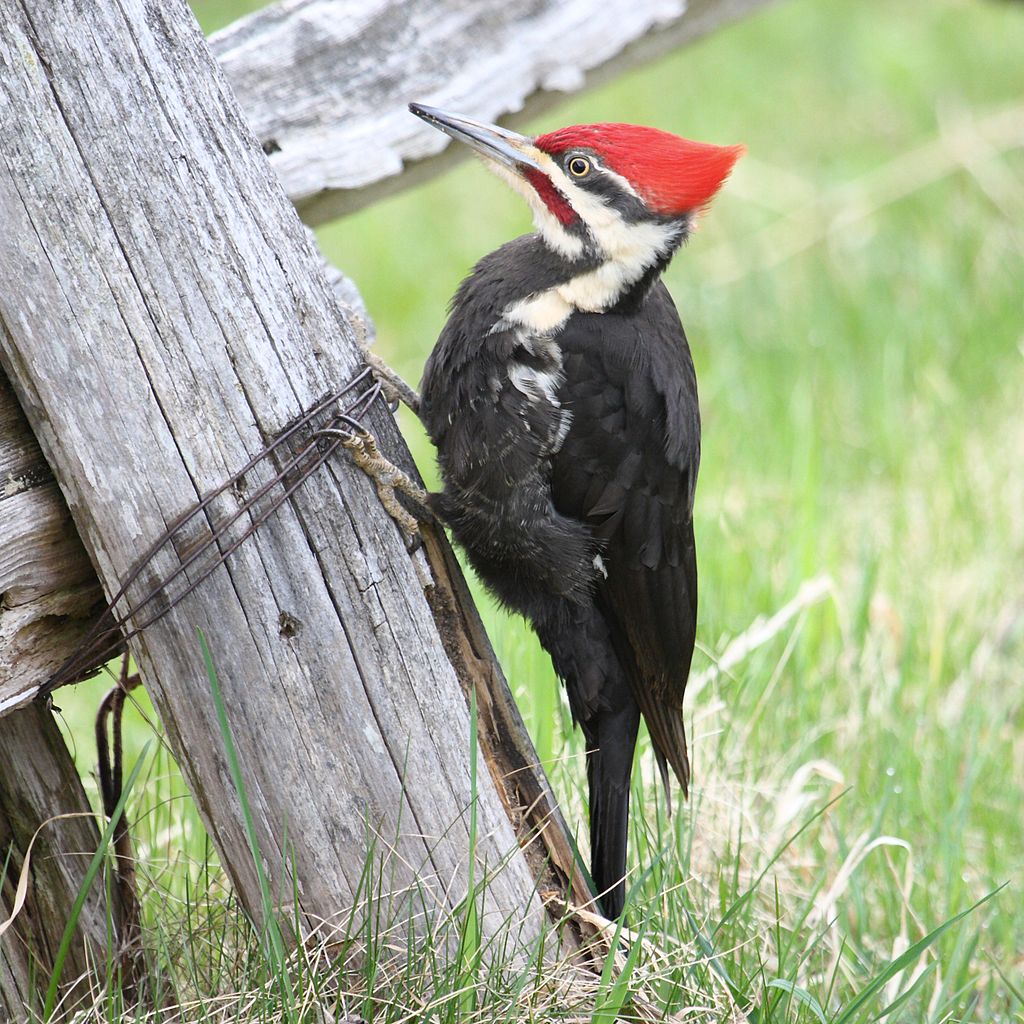
Coloration and Markings: Pileated Woodpeckers have black backs, wings, and tail with white crescent patterns on the wings readily visible when this bird is in flight. They have a black underbelly and breast, with the black travelling at a broad, vertical line up the throat to frame the cheek. Facially, this bird has a white face, with the sides of the neck white as well, and the males will have a red stripe which travels from the long, straight black bill to the location of the cheek. The identification is completed by noting the triangular red crest which this bird exhibits.
Size: Pileated Woodpeckers are large birds, measuring in at 15.8 – 19.3 inches from head to tail with a wingspan of 26 to 29.5 inches in length.
Habitat: These birds prefer deciduous or Evergreen forests but they will venture forth, preferring backyards that have some trees to make them feel more comfortable (especially hardwoods).
Diet: These birds like suet but they are especially fond of fruits and nuts. Chopped apples and peanuts are a good combination or you can go with assorted fried fruits to lure the Pileated Woodpeckers and too keep them coming.
Yellow-billed Cuckoo – Coccyzus americanus

Coloration and Markings: Yellow-billed Cuckoos have soft brown back and wings with grayish-brown, white-spotted tails. They are white of breast and underbelly and facially, this bird is white up to just under the eye, with the white spreading up over the cheek and stopping around the back of the eye, with the upper portion of the bird's head being soft brown. This bird has a medium-sized, curved black and yellow bill.
Size: These birds measure in at 10.2 – 11.8 inches in length with wingspans of 15 to 16.9 inches.
Habitat: These birds love deciduous forests. Look for them roosting high when you hear them cuckooing and you might just spot one.
Diet: These birds actually prefer moths and caterpillars, so the feeder approach won't lure them. They DO respond to empty nests in a backyard, however, the more the better. So if one or more birds picks your garden to nest in you might end up with an incidental Yellow-billed Cuckoo.
Texas's Fall and Winter Birds
Texas winters are weird. They can be warm one day and then icy the next and winter's approach often produces a bit of freak weather. As they say in Texas, though, 'if you don't like the weather, wait 5 minutes". Some of our Avian buddies are quite familiar with Texas winters and shrug it off like a true Texan. Keep your eyes peeled for these birds the next time winter rolls around:
- Orange-crowned Warbler
- Yellow-rumped Warbler
- Eastern Phoebe
- Ruby-crowned Kinglet
- Northern Cardinal
Orange-crowned Warbler – Vermivora celata
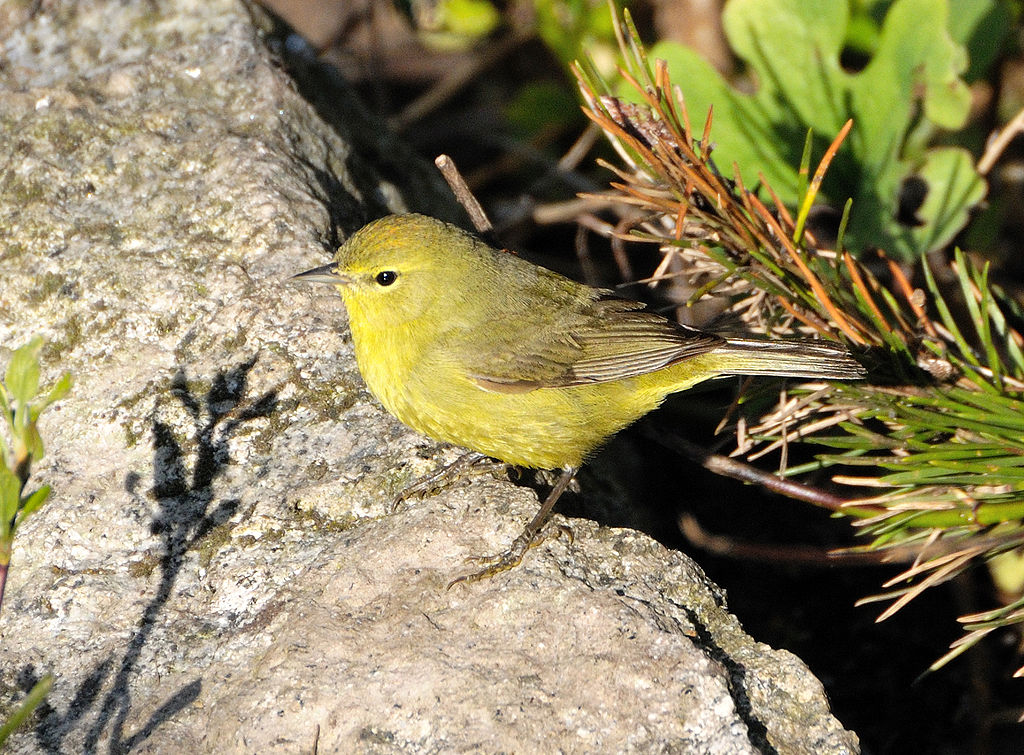
Coloration and Markings: Orange-crowned Warblers tend to be olive gray on their back, wings, and tail with touches of yellowish color present. The breast and underbelly will be yellowish-white and facially they are pale yellow from under the bill and sweeping down underneath the cheek, with the rest of the face being gray. A white or yellow stripe will be visible above the eye and a partial eyering is also present and in the top center of the bird's head is a round patch of color—the crown.
Size: These birds measure in at 4.3 – 5.5 inches in length with wingspans of approximately 7.5 inches.
Habitat: Orange-crowned Warblers are fond of deciduous forests, where they spend a lot of time on top of and inside thickets and shrubberies as they play and forage for food.
Diet: These birds love peanut butter and suet and will sometimes raid a Hummingbird feeder if you've got one. They have a sweet tooth and they love the sugar-water inside!
Yellow-rumped Warbler – Setophaga coronata
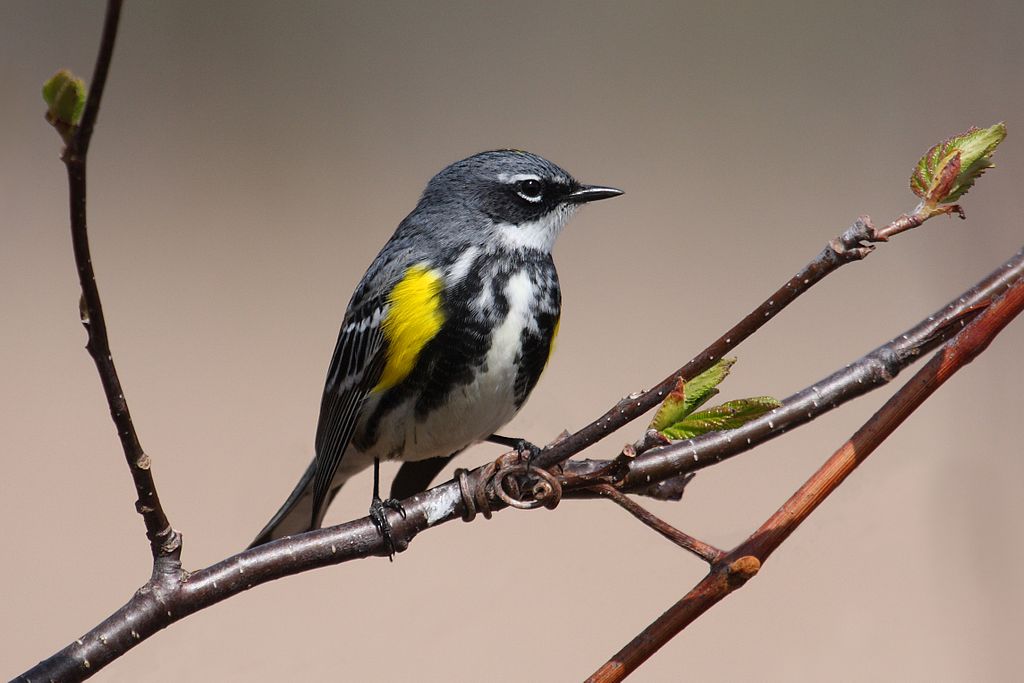
Coloration and Markings: The Yellow-rumped Warbler has gray wings, back, and tail with broad, white vertical lines often present on the wings and some white often seen in the tailfeathers. The breast of this bird is black and white, with most of the white central as if the bird is wearing a vest, and distinctive yellow splotches will be found underneath each wing. The lower belly is white and facially this bird has a bluish-gray face with a white curved eyering line present both over and under the eye and bright yellow color from the bottom of the bill down to the throat. At the top of the head there is a wisp of a yellow mark present.This bird has a medium-sized, straight bill.
Size: These birds measure in at 4.7 – 5.5 inches in length with wingspans of 7.5 to 9.1 inches.
Habitat: These birds like coniferous and deciduous forests, spending a lot of time around the edges and often paying visits to parks and backyards when they decide to range out.
Diet: Raisins, Black Oil Sunflower seeds, peanut butter, and suet are all foodstuffs that will be well-received by the Yellow-rumped Warbler.
Eastern Phoebe – Sayornis phoebe

Coloration and Markings: The Eastern Phoebe has a simple but elegant coloration scheme. The back, wings, and tail are a soft brownish-gray with some minimal white highlighting on the tips of the feathers. By contrast, the breast and underbelly of this bird are snow-white and this white continues to just up under the bill. Facially, this bird has a mostly-gray face, with the white from under the bill going across the bird's head like a band, followed by a lighter gray layer that terminates just under the eye, and above this is the darker gray seen on the rest of the body. This bird has a small, thin, and straight bill. As it gets colder their plumage changes slightly, with the white edging of the feathers becoming more prominent and the belly becoming slightly yellow.
Size: These birds measure in at 5.5 – 6.7 inches in length with wingspans of approximately 10.2 to 11 inches.
Habitat: These birds prefer open areas, such as the woodland's edge, parks, and backyards.
Diet: While they mostly eat insects, they CAN be tempted with fruits. Try some chopped apple and assorted dried fruits to attract the Eastern Phoebe to your backyard feeder.
Ruby-crowned Kinglet – Regulus calendula
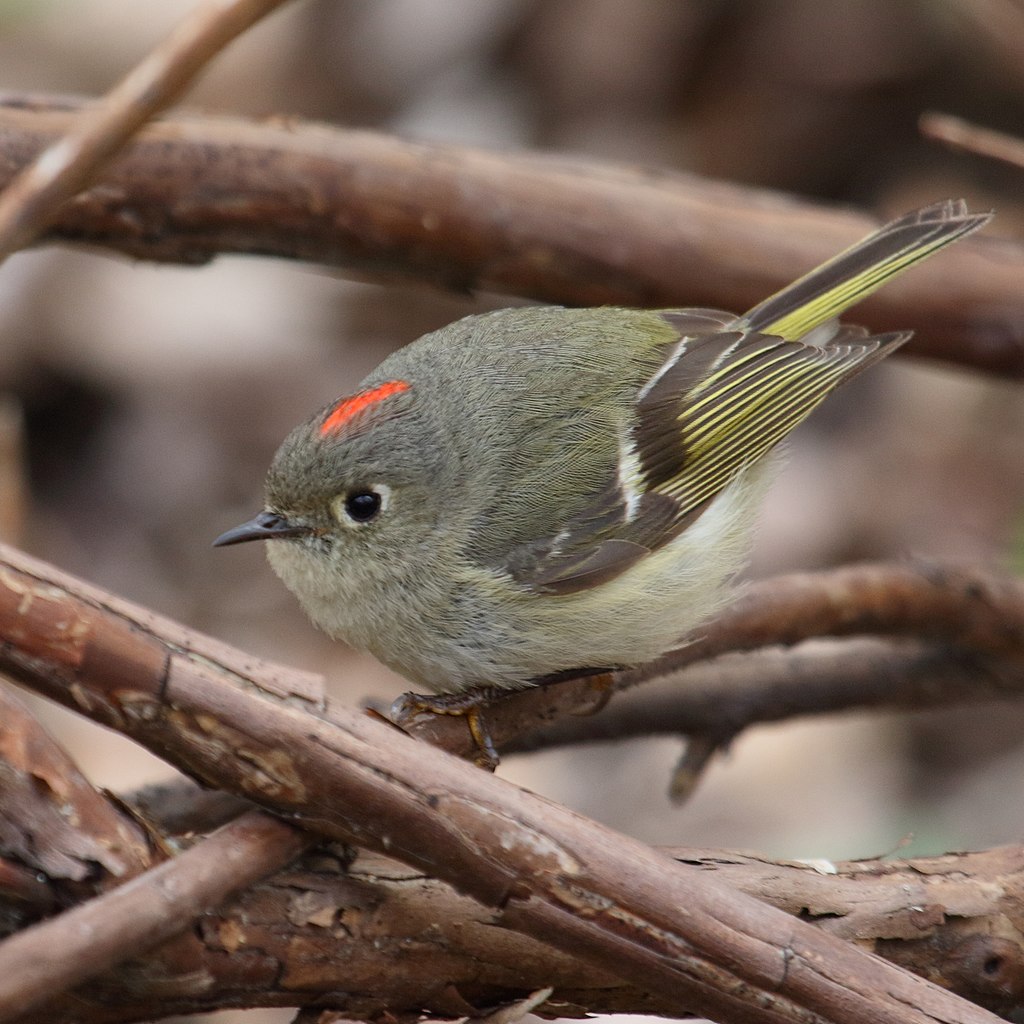
Coloration and Markings: Ruby-crowned Kinglets are a smooth olive-gray on their backs and gray and black on their wings and tail, with some tiny white edging highlighting the feathers and with olive-green present as if it were painted atop them thinly. These birds have a distinctive white wingbar which you'll notice and their breast and underbelly are a dirty-white color. Facially, this bird is ditry-white until the underside of the bill and only towards the front-center of the throat, with the rest of the face being a smooth gray. This bird has a noticeable eyering and a prominent red crest crowning it and it has a medium-sized, slightly curved black bill.
Size: These little guys measure in at 3.5 – 4.3 inches in length and have wingspans around 6.3 to 7.1 inches.
Habitat: These birds love coniferous forests but are not averse at all to the suburbs, spending times in parks and backyards as they look for lunch or dinner.
Diet: Suet and Black Oil Sunflower seeds are a great combination for these birds and if you load your feeder up with them then you might just make a new friend!
Northern Cardinal – Cardinalis cardinalis
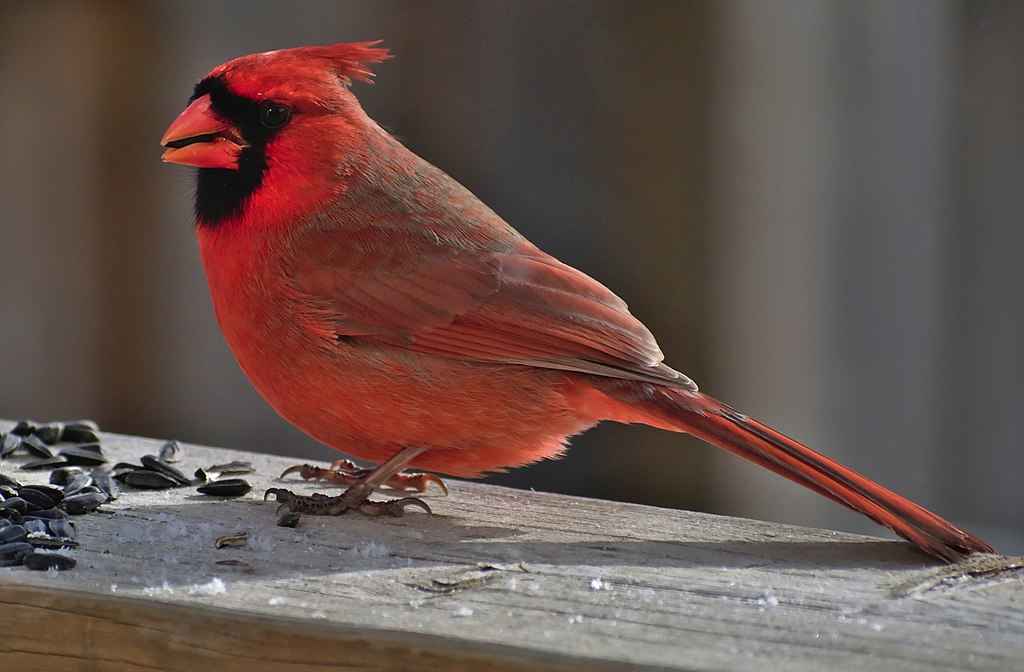
Coloration and Markings: Cardinals are strikingly beautiful and easy to identify. They are completely red with the exception of the occasional gray seen in the wing feathers. Facially, they have a distinctive mask which covers the eyes and extends down below the chin and short, conical orange bills. They have a delightful red crest to finalize the look in the male cardinal. Female Cardinals are a soft brown with some touches of red scattered about the plumage and with the same mask and bill as the male.
Size: These birds measure in at 8.3 – 9.1 inches in length with wingspans of 9.8 to 12.2 inches.
Habitat: In the wild these birds prefer areas of dense vegetation but they are fairly urbanized, spending much of their time in parks and backyards.
Diet: These birds are easy to please, just make sure that you have Black Oil Sunflower seeds in your feeder and that is all that you need.
Supporting cast (Other Backyard Birds of Texas That Might Pay You a Visit)
While we've touted our main celebrity birds as the primary focus at the beginning of this article you should know that there are quite a few other birds that you can see year-round. We like to think of our secondary year-round birds as the 'Supporting Cast' but don't let that fool you. These birds are stars all on their own:
- Black-crested Titmouse
- Couch's Kingbird
- Mourning Dove
- Blue Jay
- Carolina Wren
Black-crested Titmouse – Baeolophus atricristatus

Coloration and Markings: The Black-crested Titmouse has blue-gray wings and a long tail of the same color, with the wings darkening in color as you look towards the edges. They have a paper-white breast and underbelly and this white goes all the way up to their faces. Facially, this bird has a distinct crest that has a prominent blackish band at the front while the remaining portions of the crest are a softer blue-gray. This bird has a short, stout conical black bill.
Size: These birds measure in at approximately 5.9 inches in length with wingspans of 9.1 to 9.8 inches.
Habitat: These birds love Oak trees and may often be spotted in the wild near an Oak stand. They are also quite fond of the suburbs and will happily visit your feeder if you leave a little something out for them.
Diet: Assorted berries and peanuts are a great way to lure the Black-crested Titmouse in for a visit and to keep them coming back for more!
Couch's Kingbird – Tyrannus melancholicus

Coloration and Markings: The Couch's Kingbird is lovely and easy to identify, with grayish-brown wings, sometimes green-tinged, and long greenish-gray tails. They have a yellow breast and underbelly with a whitish throat, with a dark gray cheek splotch starting from the back of the eye, and the rest of the upper head is a soft gray. These birds have long, straight black bills.
Size: These birds measure in at 7.9 – 9.4 inches with wingspans averaging at 15.5 inches.
Habitat: Forests with thorns and thickets appeal to this bird, but they are also attracted to water so you might see one at the edge of a pond if you are lucky. They visit backyards, especially if you have a stocked feeder and some tall trees.
Diet: These birds eat insects and fruit, so you can stock the feeder up with mealworms, dried crickets, and assorted dry and fresh fruits to good effect.
Mourning Dove – Zenaida macroura
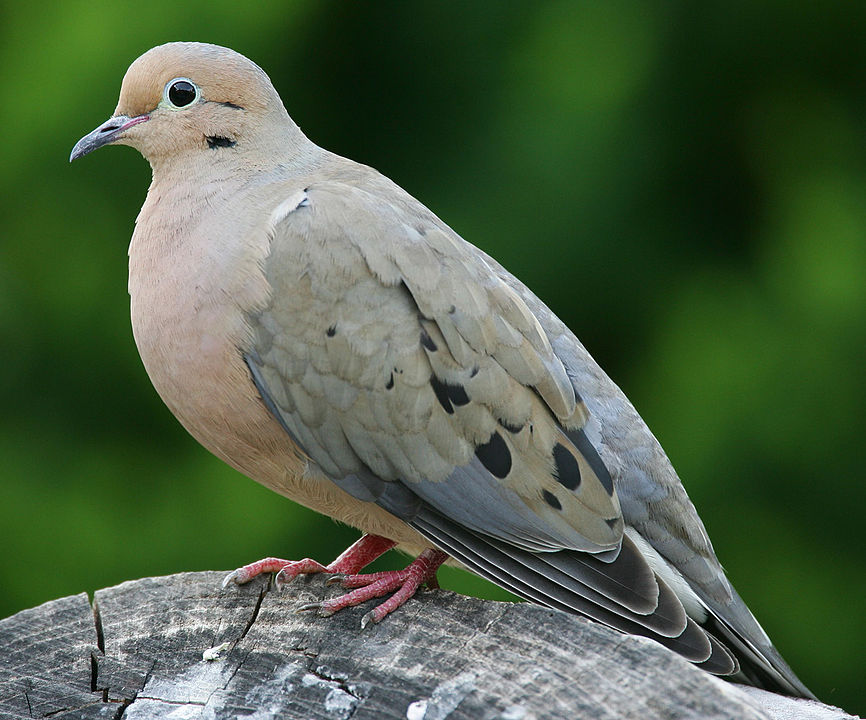
Coloration and Markings: The Mourning Dove most commonly displays tan and gray back and wings with some distinctive black spots present on the wings. They have long, grayish tails which are edged with black and a creamy tan breast with a white underbelly. Facially, these birds have more concentration of tan color on their heads as well as a prominent white eyering. These birds have short, straight bills.
Size: Roughly Robin-sized, these birds measure in at 9.1 – 13 inches in length with wingspans of approximately 17.7 inches.
Habitat: Largely urbanized, these birds tend to focus their attentions on city-dwelling and it's not uncommon to see them watching from telephone poles or high fences.
Diet: Black Oil Sunflower seeds and millet are an easy combination for attracting and keeping the attention of a Mourning Dove. Just be sure to utilize a ground feeder or scatter some seeds at the base of your current one as these birds like to ground-forage.
Blue Jay – Cyanocitta cristata
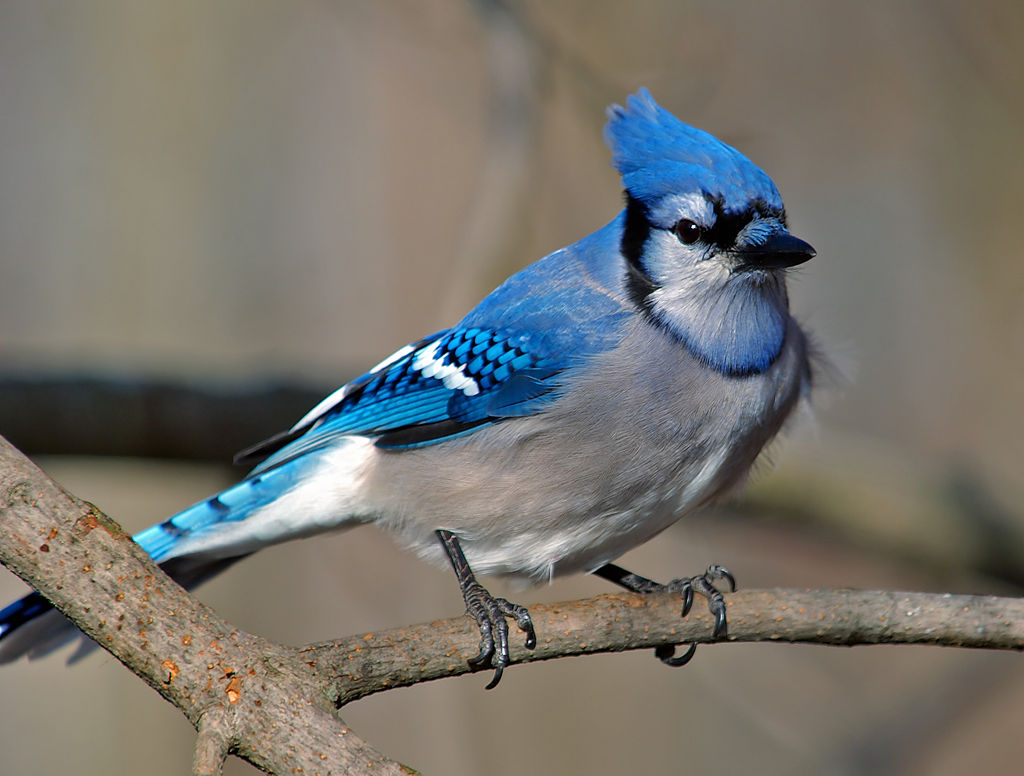
Coloration and Markings: A magical sighting no matter how many times that you see them. Blue Jays are blue on the upper halves and white below, with the wings being mostly blue with white wingbars and white marks going down to the tail. At the tail, the white becomes a more subdued blue, often showing in the form of light-blue squares on dark blue going down the tail to it's dark tip. The underside of the tail, however, is bright white, which continues on the underbelly and breast. Facially, This bird has a wide to thinning line which travels from the bright blue crest, encircling the neck to the other side. The face itself is white except for a small, somewhat abstract black mask over the eyes. This connects to the encircling line with a thin line of black and also branches out at seeming random in front of the long, straight black bill.
Size: These birds are 9.8 – 11.8 inches from head to tail and have a wingspan of approximately 13.4 to 16.9 inches.
Habitat: Blue Jays are often found at the forest's edge, especially near Oak trees, where they may obtain as many acorns as they might like. They are not of the city, however, and will happily visit your feeder if you've left something nice out.
Diet: Suet is fine, but these birds really love peanuts and Black Oil Sunflower seeds if you've got them.
Carolina Wren – Thryothorus ludovicianus
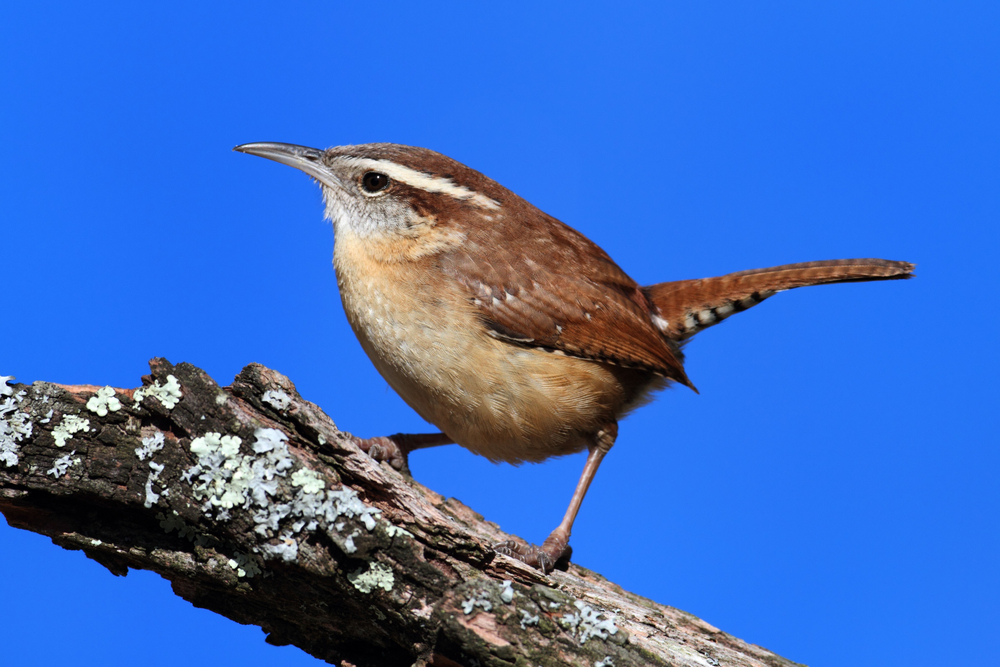
Coloration and Markings: The Carolina Wren has a reddish-brown back and shoulders and while it retains this coloration on its lower wings and on its tail you will notice some accenting of the feathers composed of white and black dots at the edge of the wing. It adds a pleasant 'checking' effect and the black and white dots turn into lighter brown dots higher up on the wing. The breast and underbelly of this bird are orangish-yellow and facially, this bird has a largely white face, with blue-gray skin around the eyes and a brown stripe travelling from the back of the eye to the back of the head. This bird also has a large, white eyebrow mark and a long, slightly curved black bill.
Size: These birds measure in at 4.7 – 5.5 inches in length with a wingspan of approximately 11.4 inches.
Habitat: Shrubs, thickets, bushes, and vines… when the vegetation gets dense these birds get comfortable. They will visit your backyard for snacks happily but your odds increase dramatically if you've got a bit of brush for them to play in.
Diet: The Carolina Wren mostly eats insects and lizards, but you can get their attention with suet and assorted dried and fresh fruit (they especially like berries!).
Texas Bird Buffet
While you'd think that Texas birds would come to the backyard if you left out a good bowl of chili (and some would, don't you doubt!), there are some better things to put out that won't leave your birdy visitors with indigestion of critical remarks about your chili. Austin Texas Parks and Recreation has some excellent suggestions in their article "Backyards that're "For the Birds"" which you can read here: https://www.austintexas.gov/blog/backyards-thatre-birds-how-create-bird-friendly-backyard-just-time-spring-and-summer
We're including some of these recommendations as well as a few of our own for making that 'perfect' bird feeder to get you the attention of the most birds. Try using the following in your feeder for best results:
- Black Oil Sunflower (whole and hulled)
- Safflower
- Cracked Corn
- Nyjer thistle
- Suet
- Peanut butter
Texas Birding Hot Spots
The Chirparazzi are a sneaky bunch, traipsing about to snap pictures of Ornithological celebrities everywhere and as such, they know ALL the good places. Here are a few that you can visit that should be 'fairly' close (Texas is a big state) and to make things easier we've selected from the compass points in various portions of the state:
- Northern hotspot – Clapp Park, Lubbock, Texas
- Eastern hotspot – Kleb Woods Nature Preserve, Hockley, Texas
- Southern hotspot – Estero Llano Grande State Park, Weslaco, Texas
- Western hotspot – Davis Mountains State Park, Fort Davis, Texas
- Central hotspot – Commons Ford Ranch Park, Austin, Texas
Detailed descriptions of each location as well as information regarding visiting and what birds you can see at these locations may be found here: http://www.texasbirds.org/birdingLocations.php?getResults=true
Final Thoughts
Today we've talked about the popular backyard birds of Texas, giving you information to identify, locate, lure, and appease the happy birds of the Lone Star state. We hope that you've enjoyed the article and that you will put this information to good use. Remember, everything in Texas is bigger so don't fret about that 600 species bird list you are going to make. It just means that you've got a lot of amazement and wonder ahead of you. Until next time, happy birding!
Source: https://birdwatchingtips.com/birds-of-texas/
0 Response to "Texas Birds With Blue Feathers Tan Front Texas"
Postar um comentário